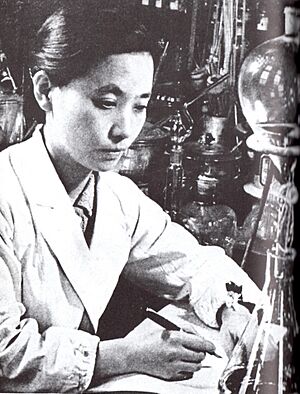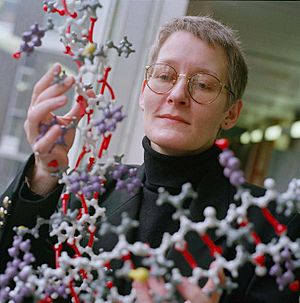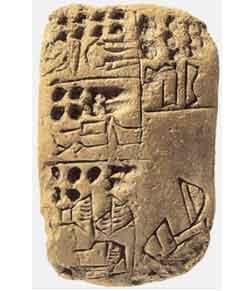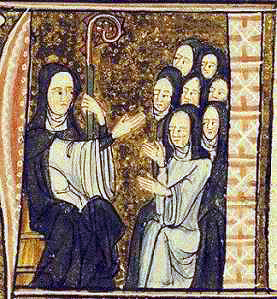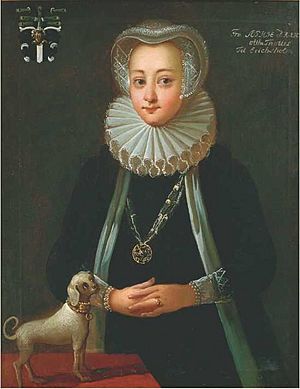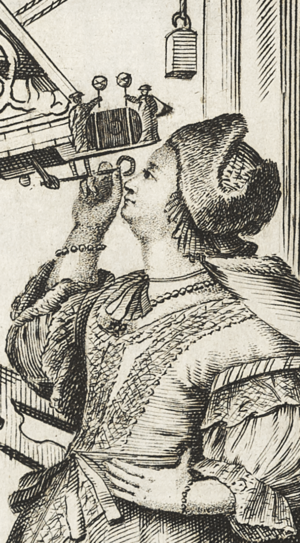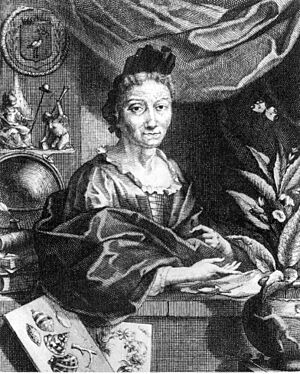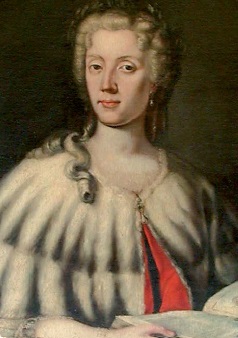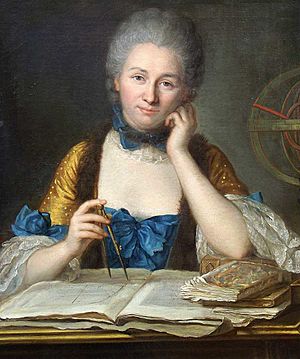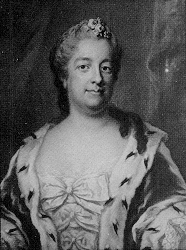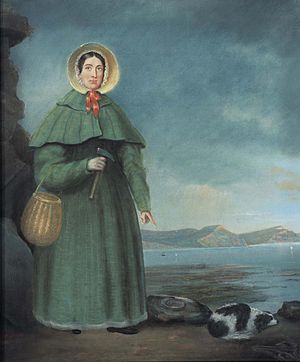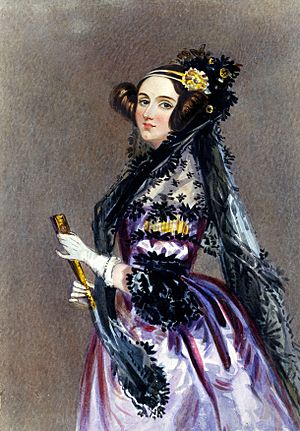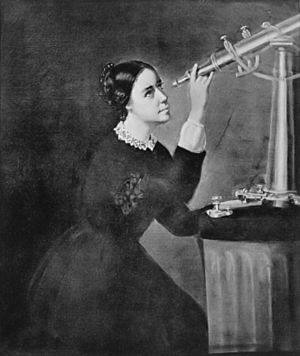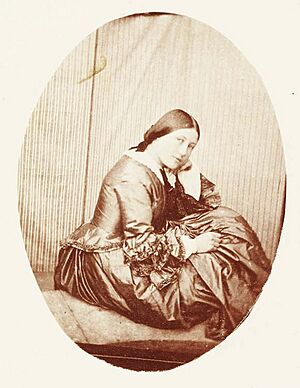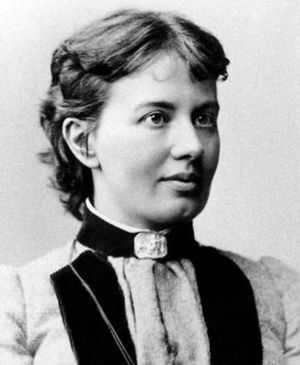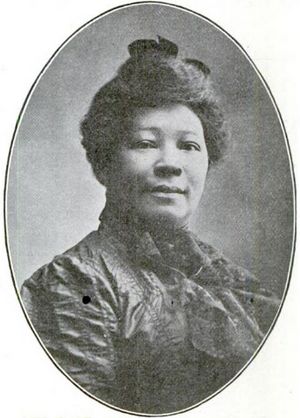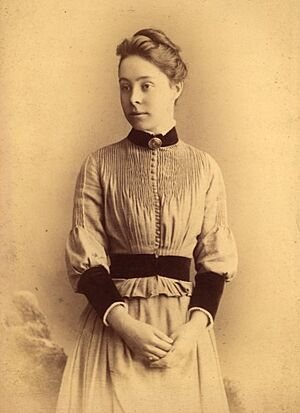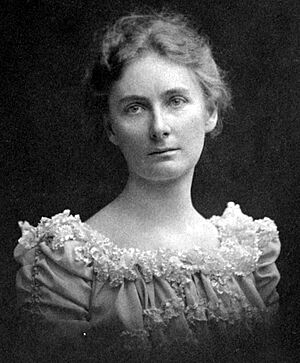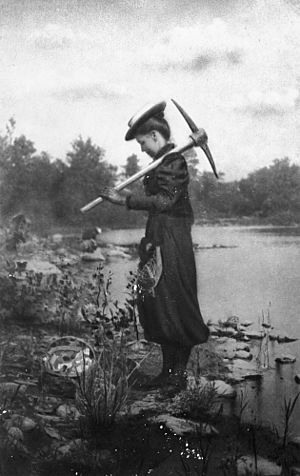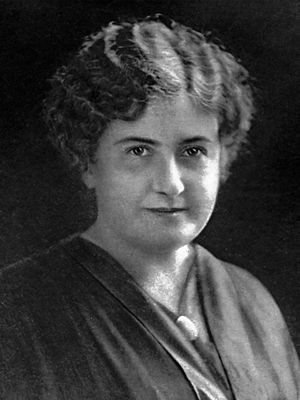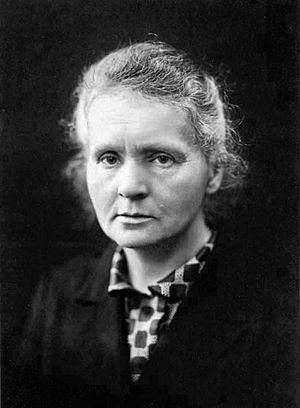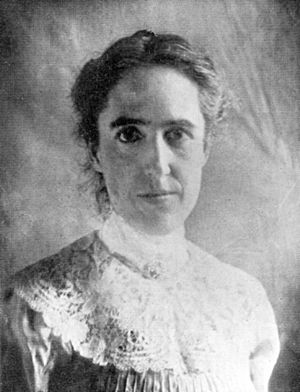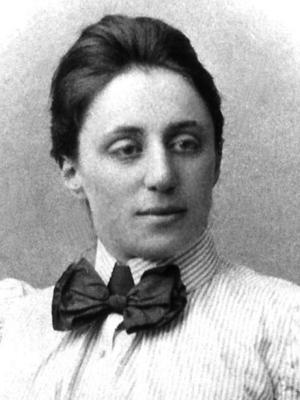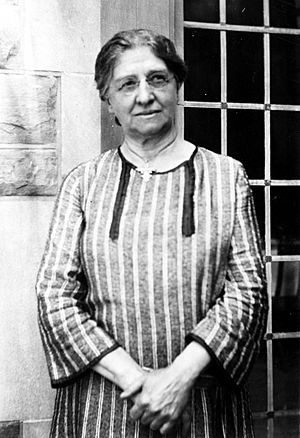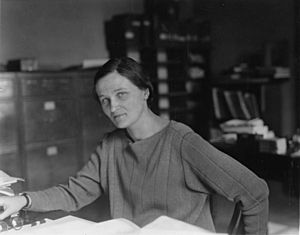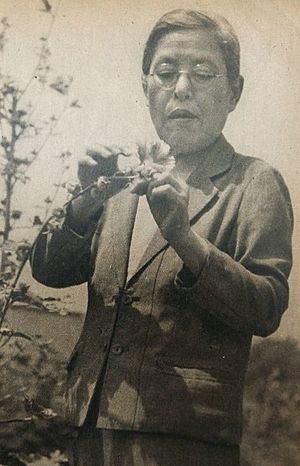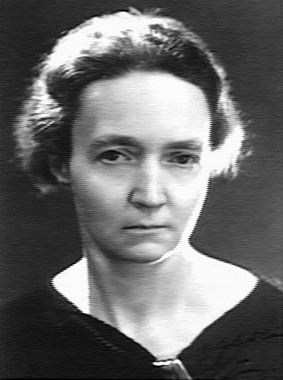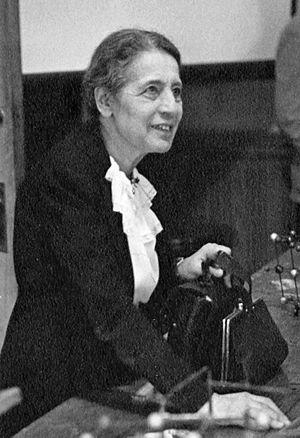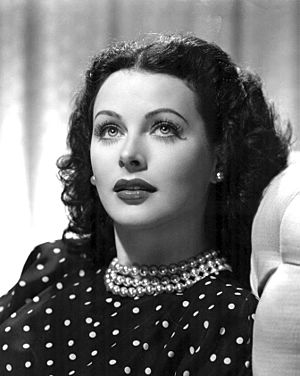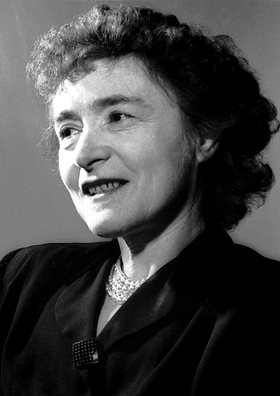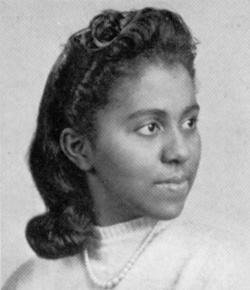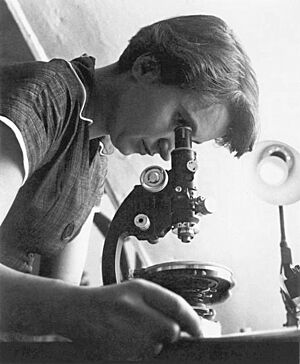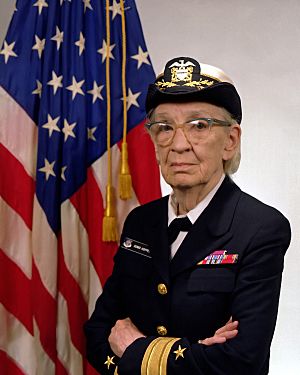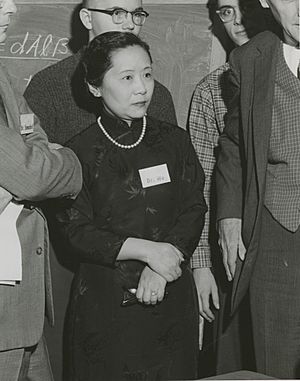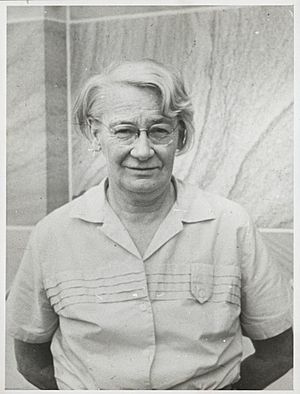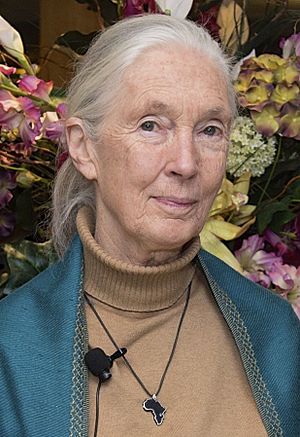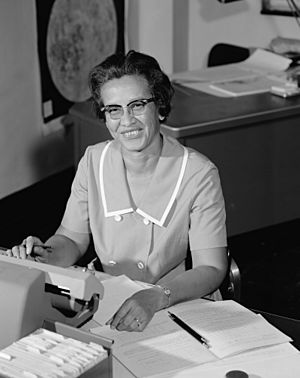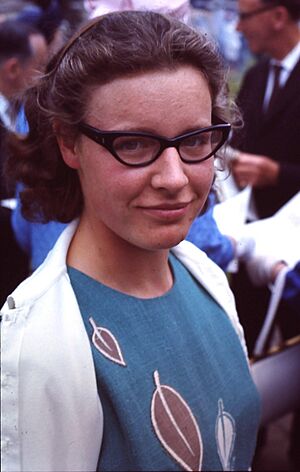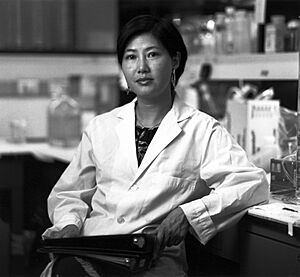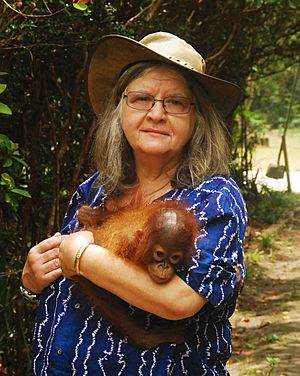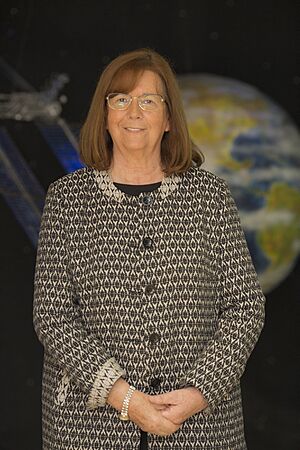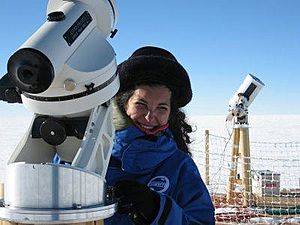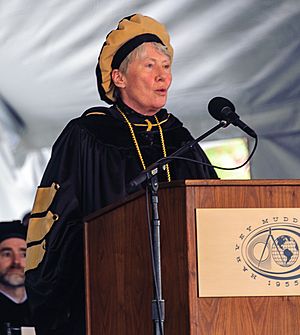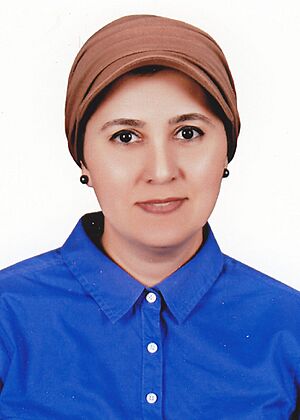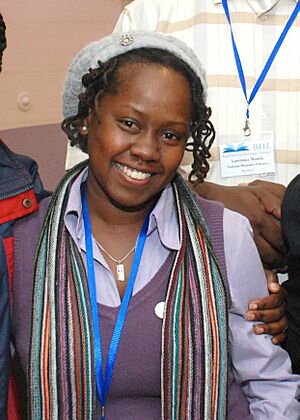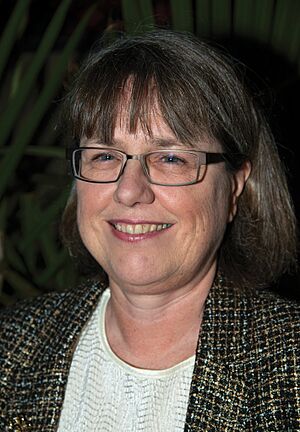Timeline of women in science facts for kids
This is a timeline showing important moments for women in science, from ancient times to today. It mainly focuses on women who studied natural sciences like astronomy, biology, chemistry, and physics. But it also includes women from social sciences (like sociology and psychology) and formal sciences (like math and computer science). You'll also find famous science teachers and medical scientists here. The timeline shares both scientific discoveries and steps towards equality for women in science.
Contents
Ancient Discoveries by Women
- 1900 BCE: Aganice, an Egyptian princess, studied astronomy and natural philosophy.
- c. 1500 BCE: Hatshepsut, also known as the Queen Doctor, led a trip to find medicinal plants.
- 1200 BCE: Tapputi-Belatekallim, a Mesopotamian perfume maker, is thought to be the world's first recorded chemist.
- 500 BCE: Theano was a philosopher who followed the ideas of Pythagoras.
- c. 150 BCE: Aglaonice became the first female astronomer known in Ancient Greece.
- 1st century BCE: Fang, an early Chinese alchemist, was known for turning mercury into silver. This was likely a chemical process to get pure silver from ores.
- 1st century CE: Mary the Jewess was one of the first alchemists in the world.
- c. 300–350 CE: Pandrosion, a Greek mathematician, found a way to estimate cube roots.
- c. 355–415 CE: Hypatia, a Greek astronomer, mathematician, and philosopher, was a respected teacher and led her own science academy.
- 3rd century CE: Cleopatra the Alchemist, an early chemist, is credited with inventing the alembic, a tool for distilling liquids.
Women in the Middle Ages
- c. 975 CE: Keng Hsien-Seng, a Chinese alchemist, worked for the Royal Court. She made perfumes and extracted camphor. She was also skilled at getting silver from ores using mercury.
- 10th century: Al-ʻIjliyyah made astrolabes, tools for astronomy, for a court in Aleppo.
- Early 12th century: Dobrodeia of Kiev, a princess, wrote the first known medical book by a woman.
- Early 12th century: Trota of Salerno, an Italian doctor, wrote about women's health and skin diseases.
- 12th century: Adelle of the Saracens taught at the Salerno School of Medicine.
- 12th century: Hildegard of Bingen helped start the study of natural history in Germany.
- 1159: Herrad of Landsberg, a nun, put together a science book called Hortus deliciarum.
- 1220s: Zulema the Astrologist was a Muslim astronomer in Medina Mayurqa.
- Early 14th century: Adelmota of Carrara was a doctor in Padua, Italy.
16th Century Breakthroughs
- 1561: Isabella Cortese, an Italian alchemist, published her popular book The Secrets of Lady Isabella Cortese. It had recipes for medicines, oils, and cosmetics.
- 1572: Loredana Marcello, an Italian botanist, developed helpful formulas for people suffering from the plague.
- 1572: Sophia Brahe, a Danish scientist, helped her brother Tycho Brahe with his astronomy observations.
- 1590: Caterina Vitale became the chief pharmacist for the Order of St John in Malta. She was the first female chemist and pharmacist there.
17th Century Pioneers
- 1609: Louise Bourgeois Boursier, a French midwife, wrote the first book by a woman on childbirth.
- 1636: Anna Maria van Schurman was the first woman to attend university lectures. She had to sit behind a screen.
- 1642: Martine Bertereau, the first recorded female mineralogist, was jailed in France. She had published works on mining and metal science.
- 1650: Maria Cunitz, a Silesian astronomer, published Urania Propitia. This book made Johannes Kepler's math for finding planets much simpler and better.
- 1656: Marie Meurdrac, a French chemist, published her book Useful and Easy Chemistry, for the Benefit of Ladies.
- 1667: Margaret Lucas Cavendish, a Duchess, was the first woman to attend a meeting at the Royal Society of London. She discussed ideas with famous philosophers.
- 1668: Marguerite de la Sablière, a French scholar, started a popular meeting place in Paris. Scientists discussed physics, astronomy, and natural history there.
- 1680: Jeanne Dumée, a French astronomer, wrote about why the Earth revolves around the Sun. She believed there was no difference between a woman's and a man's brain.
- 1685: Titia Brongersma, a Dutch archaeologist, led the first dig of a dolmen. This showed that these stone structures were ancient graves, not built by giants.
- 1690: Elisabetha Koopman Hevelius, a German-Polish astronomer, published Prodromus Astronomiae. This was the largest and most accurate star catalog of its time.
- 1693–1698: Maria Clara Eimmart, a German astronomer, drew over 350 detailed pictures of the moon's phases.
- 1699: Maria Sibylla Merian, a German entomologist, traveled to South America. She was the first scientist to show the life cycle of insects to the public. She published an important book on South American plants and insects.
18th Century Achievements
- 1702: Eleanor Glanville, an English entomologist, caught a butterfly that was named the Glanville fritillary after her. Her butterfly collection was very impressive.
- 1702: Maria Kirch, a German astronomer, was the first woman to discover a comet.
- c. 1702–1744: Catherine Jérémie, a French botanist in Canada, collected plants and sent her notes to scientists in France.
- 1732: Laura Bassi, an Italian physicist, became the first female member of the Bologna Academy of Sciences at age 20. She earned a PhD and became the world's first female physics professor.
- 1738: Émilie du Châtelet, a French scholar, was the first woman to have a paper published by the Paris Academy.
- 1740: Émilie du Châtelet published Foundations of Physics, explaining Isaac Newton's physics.
- 1748: Eva Ekeblad, a Swedish agronomist, became the first woman member of the Royal Swedish Academy of Sciences. She found a new way to make flour and alcohol from potatoes.
- 1751: Cristina Roccati, an Italian physicist, received her PhD from the University of Bologna at 19.
- 1753: Jane Colden, an American, was the only female biologist mentioned by Carl Linnaeus in his famous plant book.
- 1755: Anna Morandi Manzolini, an Italian anatomist, became a professor of anatomy at the University of Bologna. She created a famous lab for anatomy research.
- 1757: Nicole-Reine Lepaute, a French astronomer, helped calculate when Halley's Comet would return.
- 1760: Martha Daniell Logan, an American gardener, shared seeds, plants, and knowledge with botanist John Bartram.
- 1762: Nicole-Reine Lepaute calculated the time and details of a solar eclipse. She published a map and table of her findings.
- 1766: Geneviève Thiroux d'Arconville, a French chemist, published her study on how things decay. She did over 300 experiments to find ways to preserve food.
- c. 1775: Jeanne Baret, a herbalist, became the first woman to sail around the world.
- 1776: Laura Bassi became the first woman to be a physics chair at a university.
- 1776: Christine Kirch earned a good salary for making calendars.
- 1782–1791: Claudine Picardet, a French chemist, translated many scientific papers into French. This helped French scientists use international research.
- c. 1787–1797: Wang Zhenyi, a Chinese astronomer, published many books on astronomy and math. She used a lamp and mirror to show how a lunar eclipse works.
- 1786–1797: Caroline Herschel, a German astronomer, discovered eight new comets.
- 1789: Louise du Pierry, a French astronomer, taught the first astronomy classes for female students in Paris.
- 1794: Elizabeth Fulhame, a British chemist, invented the idea of catalysis and wrote a book about it.
- c. 1796–1820: Huang Lü, a Chinese astronomer, worked with optics and early photographic images. She made a telescope that could take simple photos.
- 1797: Margaret Bryan, an English science writer, published A Compendious System of Astronomy. It included a picture of her and her daughters.
Early 19th Century Discoveries
- 1808: Anna Sundström became one of the first Swedish women chemists, helping Jacob Berzelius in his lab.
- 1809: Sabina Baldoncelli earned a pharmacy degree but could only work in an orphanage.
- 1815: Lady Hester Stanhope, an English archaeologist, used an old manuscript to find an archaeological site. She was the first to start a dig in the Palestinian region.
- 1816: Sophie Germain, a French mathematician, won a prize for her work on elasticity theory.
- 1823: Mary Anning, an English fossil collector, found the first complete Plesiosaurus fossil.
- 1831: Elisabetta Fiorini Mazzanti, an Italian botanist, published her famous work Specimen Bryologiae Romanae.
- 1830–1837: Marie-Anne Libert, a Belgian botanist, published a four-volume collection of mosses, ferns, and fungi. She received a gold medal for her work.
- 1832: Jeanne Villepreux-Power, a French marine biologist, invented the first glass aquarium to study sea creatures.
- 1833: Amelia Griffiths and Mary Wyatt, English phycologists, published books on British seaweeds. A seaweed genus was named Griffithsia after Amelia.
- 1833: Orra White Hitchcock was an early American botanical and scientific illustrator. She drew for her husband's geology books, and her work is still well-known.
- 1835: Mary Somerville and Caroline Herschel were the first women elected to the Royal Astronomical Society.
- 1836: Etheldred Benett, an English geologist, was made a member of the Imperial Natural History Society of Moscow. They thought she was a man at first!
- 1840: Lady Eliza Maria Gordon-Cumming, a Scottish fossil collector, showed her fish fossils to famous geologists. They confirmed some of her discoveries were new species.
- 1843: Ada Lovelace, an English mathematician, wrote notes on Charles Babbage's Analytical Engine. Her notes included an algorithm, making her often called the first computer programmer.
- 1843: Anna Atkins, a British botanist and photographer, published Photographs of British Algae. It was the first book ever illustrated with photographs.
- 1846: Anna Thynne, a British zoologist, built the first stable, self-sustaining marine aquarium.
- 1848: Maria Mitchell, an American astronomer, was the first woman elected to the American Academy of Arts and Sciences. She had discovered a new comet the year before.
- 1848–1849: Mary Anne Whitby, an English scientist, worked with Charles Darwin on silkworm genetics.
- 1850: The American Association for the Advancement of Sciences welcomed its first women members: Maria Mitchell, Margaretta Morris, and Almira Hart Lincoln Phelps.
Late 19th Century Milestones
- 1854: Mary Horner Lyell, a conchologist and geologist, studied her collection of land snails from the Canary Islands. She helped her husband, Charles Lyell, with his scientific work.
- 1854–1855: Florence Nightingale organized care for wounded soldiers during the Crimean War. She used charts to show that most deaths were from disease, not battle wounds. This led to better hospital cleanliness.
- 1855: Thereza Dillwyn Llewelyn, a Welsh astronomer, took some of the earliest photos of the moon with her father.
- 1856: Eunice Newton Foote, an American atmospheric scientist, presented her paper on how the sun's rays affect heat. She was an early researcher of the greenhouse effect.
- 1862: Marie-Anne Libert became the first woman to join the Royal Botanical Society of Belgium.
- 1863: Amalie Dietrich, a German naturalist, collected plants and animals in Australia. She discovered new species but also took Aboriginal skeletons, which is now seen as wrong.
- 1865: Elizabeth Carne, an English geologist, was the first woman elected to the Royal Geological Society of Cornwall.
1870s
- 1869/1870: Ellen Smith Tupper, an American beekeeper, became the first female editor of an entomology journal.
- 1870: Katharine Murray Lyell wrote an early book on how ferns are found around the world.
- 1870: Ellen Swallow Richards became the first American woman to earn a chemistry degree.
- 1870: Anna Volkova, a Russian chemist, was the first woman member of the Russian Chemical Society.
- 1874: Julia Lermontova was the first Russian woman to get a PhD in chemistry.
- 1875: Zsófia Torma, a Hungarian archaeologist, dug up a site in Romania that uncovered important prehistoric artifacts.
- 1876–1878: Mary Treat, an American naturalist, studied insect-eating plants in Florida. Charles Darwin recognized her work.
- 1878: Eleanor Anne Ormerod, an English entomologist, was the first woman elected to the Royal Meteorological Society.
1880s
- 1880: Agnes Pockels, a German chemist, began studying surface tension. She developed equipment that helped with modern studies of surface films.
- 1883: Erminnie A. Smith, an American ethnologist, published her collection of Iroquois legends. She was the first female field ethnographer.
- 1884: Alice Johnson's paper on newt embryos was the first by a woman to appear in the Proceedings of the Royal Society.
- 1885: Marian Farquharson, a British naturalist, was the first woman elected to the Royal Microscopical Society.
- 1886: Emily Lovira Gregory, a botanist, was the first woman member of the American Society of Naturalists.
- 1887: Rachel Lloyd was the first American woman to get a PhD in chemistry.
- 1888: Sofia Kovalevskaya, a Russian scientist, discovered the Kovalevskaya top, a complex math problem she could solve by hand.
- 1888: Josephine Silone Yates, an American chemist, became the first black woman to lead a college science department.
- 1889: Mary Emilie Holmes, a geologist, was the first woman elected to the Geological Society of America.
1890s
- 1890: Ida Freund, an Austrian-born chemist, was the first woman to teach university chemistry in the UK.
- 1890: Agnes Giberne, a science educator, helped start the British Astronomical Association. Elizabeth Brown became its Solar Section Director, known for studying sunspots.
- 1890: Philippa Fawcett, a mathematician, got the highest score in the Cambridge Mathematical Tripos exams. Women couldn't be officially named "Senior Wrangler" then, but she outscored everyone.
- 1891: Dorothea Klumpke, an American astronomer, became Head of the Bureau of Measurements at the Paris Observatory. She worked on a star mapping project and received awards.
- 1892: Christine Ladd-Franklin, an American psychologist, presented her theory on how color vision developed.
- 1893: Florence Bascom was the second woman to get a PhD in geology in the US, and the first from Johns Hopkins University. She is called the "first woman geologist in America."
- 1893: Elizabeth Gertrude Britton, an American botanist, was a founding member of the Botanical Society of America.
- 1894: Margaretta Palmer, an American astronomer, was the first woman to earn a doctorate in astronomy.
- 1895: Marion Bidder, an English physiologist, was the first woman to speak and present her own paper at a Royal Society meeting.
- 1896: Florence Bascom was the first woman to work for the United States Geological Survey.
- 1896: Annie Lorrain Smith, an English mycologist, helped found the British Mycological Society and later served as president.
- 1897: Katharine Foot and Ella Church Strobell, American cytologists, pioneered photographing microscopic samples and a new technique for thin material samples.
- 1897: Isabelle Stone, an American physicist, was the first woman to get a PhD in physics in the US.
- 1898: Kirstine Meyer, a Danish physicist, won the gold medal from the Royal Danish Academy of Sciences and Letters.
- 1898: Marianna Paulucci, an Italian malacologist, gave her shell collection to a museum. She was the first to list Italian mollusk species.
- 1899: Marcia Keith and Isabelle Stone, American physicists, were founding members of the American Physical Society.
- 1899: Edith Anne Stoney, an Irish physicist, became the first female medical physicist. She later helped use X-ray machines on the front lines of World War I.
Early 20th Century Pioneers
1900s
- 1900: Anna Murray Vail, an American botanist, became the first librarian of the New York Botanical Garden. She had donated her large plant collection to the garden.
- 1900: Marie Skłodowska–Curie and Isabelle Stone were the only two women out of 836 people at the first International Congress of Physics in Paris.
- 1901: Florence Bascom was the first female geologist to present a paper to the Geological Survey of Washington.
- 1901: Marie Zdeňka Baborová-Čiháková, a Czech botanist, was the first woman in the Czech Republic to get a PhD.
- 1901: Annie Jump Cannon, an American astronomer, published her first catalog of star types. Her method for classifying stars by temperature was adopted worldwide.
- 1903: Grace Coleridge Frankland, an English microbiologist, wrote Bacteria in Daily Life. She was one of 19 women who asked the Chemical Society to allow female fellows.
- 1903: Marie Skłodowska–Curie, a Polish-born physicist, was the first woman to win a Nobel Prize. She won the Nobel Prize in Physics with her husband and Henri Becquerel for their work on radiation.
- 1904: Zonia Baber, an American geographer, published her ideas on teaching geography. She believed students needed field trips and lab work, not just textbooks.
- 1904: Ida Smedley, Ida Freund, and Martha Whiteley, British chemists, organized a petition for women to join the Chemical Society. It was denied.
- 1904: Marie Charlotte Carmichael Stopes, a British palaeobotanist, became the first female academic at the University of Manchester. She was elected to the Linnean Society of London at 26, the youngest woman at that time.
- 1904: The Linnean Society of London elected its first women Fellows, including Ellen Willmott, Emma Turner, and Annie Lorrain Smith.
- 1905: Nettie Stevens, an American geneticist, discovered sex chromosomes.
- 1906: Alice Eastwood, an American botanist, saved nearly 1500 rare plant specimens from a burning building after the San Francisco earthquake.
- 1906: Irma Goldberg, a Russian chemist, published on new chemical reactions involving copper. These reactions were named after her.
- 1906: Hertha Ayrton, an English physicist, was the first woman to receive the Hughes Medal from the Royal Society. She won for her work on electric arcs and sand ripples.
- 1906: Emma Hutchinson's collection of 20,000 butterflies was given to the London Natural History Museum after her death. A butterfly variant was named hutchinsoni after her.
- 1909: Alice Wilson was the first female geologist hired by the Geological Survey of Canada.
- 1909: Kirstine Meyer, a Danish physicist, was the first Danish woman to get a doctorate in natural sciences. She wrote about the history of the temperature concept.
1910s
- 1911: Marie Curie was the first person to win the Nobel Prize twice. She won the Nobel Prize in Chemistry for discovering radium and polonium. She is the only woman to win it twice and the only person to win Nobel Prizes in two different science fields.
- 1911: Kristine Bonnevie, a Norwegian biologist, was the first woman member of the Norwegian Academy of Science and Letters.
- 1912: Henrietta Swan Leavitt, an American astronomer, found a way to calculate distances to stars by studying their bright-dim cycles.
- 1912: Carrie Derick, a Canadian geneticist, became the first woman to be a full professor at a Canadian university.
- 1913: Regina Fleszarowa was the first Polish woman to get a PhD in natural sciences.
- 1913: Izabela Textorisová, the first Slovakian woman botanist, found over 100 new plant species.
- 1913: Maud Menten, a Canadian physician, helped create the Michaelis–Menten kinetics equation, important for understanding enzymes.
- 1914–1918: During World War I, a team of seven British women chemists, led by Martha Whiteley, researched chemical antidotes and weaponized gases. Martha was awarded for her contributions.
- 1914: Ethel Doidge, a British mycologist, was the first woman in South Africa to get a doctorate in any subject.
- 1916: Isabella Preston was the first female professional plant hybridist in Canada. Her lily received an award.
- 1916: Chika Kuroda was the first Japanese woman to earn a bachelor of science degree in chemistry.
- 1917: Mary J. Rathbun, an American zoologist, received her PhD despite no formal college. She wrote over 80 scientific papers and described many new crustacean species.
- 1917: Jantina Tammes, a Dutch geneticist, became the first female university professor in the Netherlands.
- 1918: Emmy Noether, a German mathematician, created Noether's theorem, which links symmetry and conservation laws in physics.
- 1919: Kathleen Maisey Curtis was the first New Zealand woman to earn a Doctorate of Science degree for her research on potato wart disease.
1920s
- 1920: Louisa Bolus, a botanist, was elected a Fellow of the Royal Society of South Africa. She identified over 1,700 new South African plant species.
- 1923: María Teresa Ferrari, an Argentine physician, earned the first diploma awarded to a woman by the University of Paris's Faculty of Medicine.
- 1924: Florence Bascom was the first woman elected to the Council of the Geological Society of America.
- 1925: Ynes Mexia, a Mexican-American botanist, began her first plant expedition. Over 13 years, she collected over 145,000 plant specimens and discovered 500 new species.
- 1925: Florence Sabin, an American medical scientist, was the first woman elected to the National Academy of Sciences.
- 1925: Cecilia Payne-Gaposchkin, an astronomer, proved that hydrogen is the most common element in stars and the universe.
- 1927: Kono Yasui was the first Japanese woman to earn a doctorate in science, studying the structure of coal.
- 1928: Alice Evans was the first woman elected president of the Society of American Bacteriologists.
- 1928: Helen Battle was the first woman to earn a PhD in marine biology in Canada.
- 1928: Kathleen E. Carpenter, a British biologist, published the first English textbook on freshwater ecology.
- 1929: Margaret Clay Ferguson, an American botanist, was the first woman president of the Botanical Society of America.
- 1929: Agnes Yewande Savage was the first West African woman to graduate from medical school.
1930s
- 1930: Concepción Mendizábal Mendoza was the first woman in Mexico to earn a civil engineering degree.
- 1932: Michiyo Tsujimura was the first Japanese woman to earn a doctorate in agriculture. Her thesis was on the chemical parts of green tea.
- 1933: Elizabeth Rona, a Hungarian scientist, won a prize for her method of extracting polonium.
- 1933: Ruth Ella Moore, an American bacteriologist, was the first African-American woman to get a PhD in natural sciences.
- 1935: Irène Joliot-Curie, a French chemist, received the Nobel Prize in Chemistry with Frédéric Joliot-Curie for making new radioactive elements.
- 1935: Grace Sturtevant, an American plant hybridist, received a gold medal for her work with irises.
- 1936: Edith Patch was the first female president of the Entomological Society of America.
- 1936: Kathleen Maisey Curtis was the first female Fellow elected to the Royal Society of New Zealand.
- 1936: Inge Lehmann, a Danish seismologist, discovered that Earth has a solid inner core different from its molten outer core.
- 1937: Frances Gertrude McGill, a Canadian forensic pathologist, helped set up the first forensic lab for the Royal Canadian Mounted Police.
- 1937: Suzanne Comhaire-Sylvain was the first female Haitian anthropologist and the first Haitian person to complete a PhD.
- 1937: Marietta Blau and Hertha Wambacher, Austrian physicists, won a prize for their work on cosmic ray observations.
- 1938: Elizabeth Abimbola Awoliyi was the first woman licensed to practice medicine in Nigeria.
- 1938: Alice Wilson, a geologist, was the first woman appointed as Fellow to the Royal Society of Canada.
- 1938: Marjorie Courtenay-Latimer, a South African naturalist, discovered a living coelacanth fish, thought to be extinct for over 60 million years. It was named latimeria chalumnae after her.
- 1939: Lise Meitner, an Austrian-Swedish physicist, helped discover nuclear fission of uranium.
- 1939: Marguerite Perey, a French physicist, discovered francium.
1940s
- 1940: Muazzez İlmiye Çığ, a Turkish archaeologist, worked on translating thousands of ancient cuneiform tablets. Her efforts made the museum a learning center for ancient languages.
- 1941: Ruth Smith Lloyd, an American scientist, was the first African-American woman to get a PhD in anatomy.
- 1942: Hedy Lamarr, an actress and inventor, developed a radio guidance system for torpedoes that used spread spectrum technology. This idea is now in Bluetooth and Wi-Fi.
- 1942: Marguerite Williams, an American geologist, was the first African-American woman to get a PhD in geology in the US.
- 1942: Mary Golda Ross, a Native American aerospace engineer, worked for Lockheed and NASA. She helped develop flight plans for missions like the Apollo program.
- 1943: Eileen Guppy, a British geologist, was the first female geology graduate appointed to the scientific staff of the British Geological Survey.
- 1944: Asima Chatterjee, an Indian chemist, was the first Indian woman to get a doctorate of science. She later started the Chemistry Department at Lady Brabourne College.
- 1945: Frances Spence, Ruth Teitelbaum, Marlyn Meltzer, Betty Holberton, Jean Bartik, and Kathleen Antonelli programmed the ENIAC computer. They were some of the world's first computer programmers.
- 1945: Marjory Stephenson and Kathleen Lonsdale were the first women elected as Fellows of the Royal Society.
- 1947: Gerty Cori, an Austrian-American biochemist, was the first woman to win the Nobel Prize in Physiology or Medicine for her discovery about glycogen conversion.
- 1947: Marie Maynard Daly, an American biochemist, was the first African-American woman to complete a PhD in chemistry in the US.
- 1947: Berta Karlik, an Austrian physicist, won a prize for her discovery of astatine.
- 1947: Susan Ofori-Atta was the first Ghanaian woman to earn a medical degree.
- 1948: Margaret Newton, a Canadian plant pathologist, was the first woman to win the Flavelle Medal for her research on wheat rust fungal disease. Her work led to rust-resistant wheat.
- 1948: Ruth Patrick, an American limnologist, led a team studying river pollution. She became a leading expert on the environmental effects of pollution.
- 1949: Valida Tutayug, a botanist, was the first Azerbaijani woman to get a PhD in biological studies. She wrote the first Azerbaijani textbooks on botany.
- 1949: Winifred Goldring was the first woman president of the Paleontological Society. She was also the first woman in the US to be appointed as a State Paleontologist.
Late 20th Century Innovations
1950s
- 1950s: Tsai-Fan Yu, a Chinese-American medical scientist, helped start a clinic for gout. She found that uric acid levels caused pain and developed effective drugs for gout.
- 1950: Chien-Shiung Wu, a Chinese-American particle physicist, proved the validity of quantum entanglement and beta decay.
- 1950: Matilda J. Clerk was the first woman in Ghana and West Africa to attend graduate school.
- 1950: Isabella Abbott was the first Native Hawaiian woman to get a PhD in any science, hers was in botany.
- 1950: Esther Lederberg, an American microbiologist, was the first to isolate a DNA virus called lambda bacteriophage.
- 1951: Esther Afua Ocloo was the first person of African ancestry to get a cooking diploma from the Good Housekeeping Institute in London.
- 1952: Grace Hopper, an American computer scientist, created the first compiler. This program allowed computers to use human-readable languages instead of complex machine code.
- 1952: Photograph 51, an X-ray image of DNA, was taken by Raymond Gosling under Rosalind Franklin's supervision. It was key to understanding DNA's structure.
- 1952: Mary MacArthur, a Canadian agriculturalist, was the first female Fellow of the Agricultural Institute of Canada for her work in food dehydration and freezing.
- 1953: Alma Howard, a Canadian-British radiobiologist, helped propose that cellular life goes through four distinct periods. This became the first idea of the cell cycle.
- 1954: Lucy Cranwell was the first woman to receive the Hector Medal for her work with pollen in palynology.
- 1955: Moira Dunbar was the first female glaciologist to study sea ice from a Canadian icebreaker ship.
- 1955: Katsuko Saruhashi, a Japanese geochemist, published her research on measuring carbonic acid in seawater. Her "Saruhashi's Table" was used by oceanographers for 30 years.
- 1955–1956: Maria Klenova, a Soviet marine biologist, was the first woman scientist to work in the Antarctic.
- 1956: Anne Innis Dagg, a Canadian zoologist, began studying wild giraffes in South Africa.
- 1956: Chien-Shiung Wu conducted the Wu experiment, showing that parity could be violated in weak interaction. This was important for particle physics.
- 1956: Dorothy Hill was the first Australian woman elected a Fellow of the Australian Academy of Science.
- 1956: Margaret Bastock, an English zoologist, showed that a single gene could change behavior.
- 1957–1958: Lanying Lin, a Chinese scientist, produced China's first germanium and silicon mono-crystals, helping develop semiconductors.
- 1959: Ye Shuhua, a Chinese astronomer, led the creation of the Joint Chinese Universal Time System, which became China's standard for measuring universal time.
- 1959: Susan Ofori-Atta, the first Ghanaian woman physician, helped found the Ghana Academy of Arts and Sciences.
1960s
- 1960: Jane Goodall, a British primatologist, began studying chimpanzees in Tanzania. Her work showed that chimpanzees use tools and eat more than just plants.
- Early 1960s: Ursula Franklin, a German-Canadian metallurgist, studied radioactive strontium-90 in children's teeth from nuclear weapons fallout. Her research influenced the Partial Nuclear Test Ban Treaty of 1963.
- 1960s: Katherine Johnson, an American mathematician, calculated flight paths for NASA's crewed space flights.
- 1961: Asima Chatterjee, an Indian chemist, was the first woman to receive a Shanti Swarup Bhatnagar Prize for her work in phytomedicine.
- 1962: Rachel Louise Carson, an American marine biologist, wrote Silent Spring. Her book helped start the global environmental movement.
- 1962: Margaret Levyns, a South African botanist, was the first woman president of the Royal Society of South Africa.
- 1962: Marguerite Perey, a French physicist, was the first female Fellow elected to the Académie des Sciences.
- 1963: Elsa G. Vilmundardóttir was the first female Icelandic geologist.
- 1963: Maria Goeppert Mayer was the first American woman to win a Nobel Prize in Physics for her discoveries about nuclear shell structure.
- 1964: Irene Stegun, an American mathematician, completed the Handbook of Mathematical Functions, a widely used reference in math.
- 1964: Dorothy Crowfoot Hodgkin, a British chemist, received the Nobel Prize in Chemistry for figuring out the structures of important biochemical substances using X-ray techniques.
- 1964: June Almeida, a Scottish virologist, made the first identification of a human coronavirus.
- 1965: Sister Mary Kenneth Keller was the first American woman to get a Ph.D. in computer science.
- 1966: Teruko Ishizaka, a Japanese immunologist, discovered the antibody class Immunoglobulin E (IgE).
- 1967: Jocelyn Bell Burnell, a British astrophysicist, helped discover the first radio pulsars.
- 1967: Sue Arnold was the first female British Geological Survey person to go to sea on a research vessel.
- 1967: Tikvah Alper, a South African radiobiologist, discovered that scrapie, a brain disease, didn't spread like a virus. This helped scientists understand prion diseases.
- 1967: Yvonne Brill, a Canadian-American engineer, invented the hydrazine resistojet propulsion system for rockets.
- 1968: Tsuneko Okazaki, a Japanese molecular biology pioneer, studied DNA replication and discovered Okazaki fragments.
- 1969: Beris Cox was the first female paleontologist in the British Geological Survey.
- 1969: Svetlana Gerasimenko, an astronomer, helped discover the 67P/Churyumov–Gerasimenko comet.
1970s
- 1970: Dorothy Hill was the first female president of the Australian Academy of Science.
- 1970: Samira Islam was the first Saudi Arabian person to get a PhD in pharmacology.
- 1970: Vera Rubin, an astronomer, published the first evidence for dark matter.
- 1970: Franciszka Szymakowska, a Polish geologist, became known for her detailed geological drawings still used today.
- 1973: Anna Coble, an American physicist, was the first African-American woman to get a PhD in biophysics.
- 1974: Idelisa Bonnelly, a Dominican marine biologist, founded the Dominican Republic Academy of Science.
- 1975: Asima Chatterjee, an Indian chemist, was the first woman scientist elected General President of the Indian Science Congress Association.
- 1975: Archana Sharma, an Indian geneticist, was the first woman to receive the Shanti Swarup Bhatnagar Prize in Biological Sciences.
- 1975: Female officers of the British Geological Survey no longer had to resign when they got married.
- 1975: Chien-Shiung Wu was the first female president of the American Physical Society.
- 1976: Roseli Ocampo-Friedmann, a Filipino-American microbiologist, discovered micro-organisms living inside rocks in Antarctica. These organisms survived extreme cold, helping research on life on Mars.
- 1976: Margaret Burbidge was the first female president of the American Astronomical Society.
- 1977: Rosalyn Yalow, an American medical physicist, received the Nobel Prize in Physiology or Medicine for developing radioimmunoassays for hormones.
- 1977: Joy Adamson, a naturalist and author, was awarded the Austrian Cross of Honour for Science and Art. Her book Born Free was a bestseller.
- 1977: The Association for Women Geoscientists was founded.
- 1977: Veronica Dahl, an Argentine-Canadian scientist, was one of the first women in the world to earn a PhD in artificial intelligence.
- 1978: Anna Jane Harrison was the first female president of the American Chemical Society.
- 1978: Mildred Cohn was the first female president of the American Society for Biochemistry and Molecular Biology.
1980s
- 1980: Katsuko Saruhashi, a Japanese geochemist, was the first woman elected to the Science Council of Japan.
- 1980: Deborah Ajakaiye, a Nigerian geophysicist, was the first woman in West Africa to be a full physics professor. She was also the first female Fellow of the Nigerian Academy of Science.
- 1981: Vera Rubin was the second woman astronomer elected to the National Academy of Science. Her work provided evidence for galactic superclusters.
- 1982: Leah Lowenstein, a nephrologist, was the first woman dean of a co-educational medical school in the United States.
- 1982: Janet Vida Watson, a British geologist, was the first woman to be elected President of the Geological Society of London.
- 1983: Barbara McClintock, an American cytogeneticist, received the Nobel Prize in Physiology or Medicine for discovering genetic transposition. She was the first woman to win that prize alone.
- 1983: Johanna Döbereiner, a Brazilian agronomist, was a founding Fellow of the World Academy of Sciences.
- 1983: Indira Nath, an Indian immunologist, was the first woman scientist to receive the Shanti Swaroop Bhatnagar Award in Medical Sciences.
- 1983: Sudipta Sengupta and Aditi Pant were the first Indian women to visit the Antarctic.
- 1985: Flossie Wong-Staal, a Chinese-American virologist, was the first scientist to clone and map the HIV virus. This helped create the first HIV blood screening tests.
- 1986: Rita Levi-Montalcini, an Italian neurologist, received the Nobel Prize in Physiology or Medicine for discovering growth factors.
- 1988: Gertrude B. Elion, an American biochemist, received the Nobel Prize in Physiology or Medicine for her discoveries in drug treatment.
- 1988: Patricia Bath, an American scientist, was the first African-American woman to patent a medical device. It was the Laserphaco Probe for cataract removal.
1990s
- 1991: Doris Malkin Curtis was the first woman president of the Geological Society of America.
- 1991: Sudipta Sengupta, an Indian geologist, was the first woman scientist to receive the Shanti Swaroop Bhatnagar Award in Earth Sciences.
- 1991: Helen Patricia Sharman, a chemist, became the first British astronaut and the first woman to visit the Mir space station.
- 1992: Mae Carol Jemison, an American engineer and physician, was the first black woman to travel into space aboard the Space Shuttle Endeavour.
- 1992: Edith M. Flanigen was the first woman to receive the Perkin Medal, a top honor in American industrial chemistry. She was recognized for creating new materials.
- 1995: Christiane Nüsslein-Volhard, a German biologist, received the Nobel Prize in Physiology or Medicine for her discoveries about genetic control of early embryonic development.
- 1995: Marjorie Sweeting, a British geomorphologist, published the first full Western book on China's karst landscapes.
- 1995: Leah Keshet, an Israeli-Canadian mathematical biologist, was the first woman president of the Society for Mathematical Biology.
- 1995: Jane Plant was the first female Deputy Director of the British Geological Survey.
- 1995: Inspectors found that Rihab Taha, an Iraqi microbiologist, was leading a secret biological warfare program in Iraq.
- 1996: Margaret G. Kivelson, an American planetary scientist, led a team that found the first underground saltwater ocean on Europa, a moon of Jupiter.
- 1997: Birutė Galdikas, a Lithuanian-Canadian primatologist, received the Tyler Prize for Environmental Achievement for her work with orangutans. Her studies are among the longest continuous studies of wild animals.
- 1997: María Teresa Ruiz, a Chilean astronomer, discovered Kelu 1, one of the first brown dwarfs. She was the first woman to receive Chile's National Prize for Exact Sciences.
- 1998: Fannie Gaston-Johansson, a nurse, was the first African-American woman to become a tenured full professor at Johns Hopkins University.
- Late 1990s: Sossina M. Haile, an Ethiopian-American chemist, developed the first solid acid fuel cell.
21st Century Achievements
2000s
- 2000: Kathy Vivas, a Venezuelan astrophysicist, discovered about 100 new and very distant RR Lyrae stars. This helped understand the Milky Way galaxy.
- 2003: Claudia Alexander, an American geophysicist, oversaw the final stages of Project Galileo, a mission to Jupiter.
- 2004: Linda B. Buck, an American biologist, received the Nobel Prize in Physiology or Medicine for discovering odorant receptors and how the olfactory system works.
- 2006: Cecilia Hidalgo Tapia, a Chilean biochemist, was the first woman to receive Chile's National Prize for Natural Sciences.
- 2006: Yizhi Jane Tao, a Chinese-American biochemist, led a team that mapped the atomic structure of Influenza A. This helped antiviral research.
- 2006: Susan Lim was the first Malaysian scientist elected to the International Commission on Zoological Nomenclature.
- 2006: Merieme Chadid was the first Moroccan person and first female astronomer to travel to Antarctica. She led a team installing a major observatory there.
- 2006: Frances E. Allen, an American computer scientist, won the Turing Award for her work on optimizing compilers. She was the first woman to win this award.
- 2006: Maria Klawe, a Canadian-American computer scientist, became the president of Harvey Mudd College.
- 2007: Eman Ghoneim, an Egyptian geomorphologist, used satellite images to find traces of an 11,000-year-old mega lake in the Sahara Desert.
- 2007: Ibtesam Badhrees was the first Saudi Arabian woman to join CERN (European Organization for Nuclear Research).
- 2008: Françoise Barré-Sinoussi, a French virologist, received the Nobel Prize in Physiology or Medicine for discovering HIV.
- 2008: Penny Sackett was Australia's first female Chief Scientist.
- 2008: Barbara Liskov, an American computer scientist, won the Turing Award for her work in programming language and system design.
- 2009: Carol W. Greider, an American molecular biologist, received the Nobel Prize in Physiology or Medicine for discovering how chromosomes are protected by telomeres and the enzyme telomerase.
- 2009: Ada E. Yonath, an Israeli crystallographer, received the Nobel Prize in Chemistry for studying the ribosome's structure and function.
- 2009: Zeng Fanyi, a Chinese geneticist, and her team showed that induced pluripotent stem cells could create whole mammalian bodies, like live mice.
2010s
- 2010: Marcia McNutt became the first female director of the United States Geological Survey.
- 2011: Alexandra Elbakyan, a neuroscience student, launched Sci-Hub, a website that provided pirated copies of scientific papers.
- 2011: Chung-Pei Ma, a Taiwanese-American astrophysicist, led a team that discovered two of the largest black holes ever seen.
- 2012: Shafi Goldwasser, a computer scientist, won the Turing award for her work in cryptography.
- 2013: Turi King, a Canadian genetic specialist, identified the 500-year-old skeleton of King Richard III.
- 2013: Dorothy Wanja Nyingi, a Kenyan ichthyologist, published the first guide to freshwater fish species of Kenya.
- 2014: May-Britt Moser, a Norwegian neuroscientist, received the Nobel Prize in Physiology or Medicine for discovering cells that help the brain's positioning system.
- 2014: Maureen Raymo, an American paleoclimatologist, was the first woman to receive the Wollaston Medal, the highest award from the Geological Society of London.
- 2014: Shirley Ann Jackson, an American theoretical physicist, received the National Medal of Science. She was the first African-American woman to get a PhD from MIT.
- 2014: Maryam Mirzakhani, an Iranian mathematician, was the first woman to receive the Fields Medal for her work in geometry.
- 2015: Tu Youyou, a Chinese medical scientist, received the Nobel Prize in Physiology or Medicine for her discoveries about a new malaria therapy.
- 2015: Asha de Vos was the first Sri Lankan person to get a PhD in marine mammal research.
- 2016: Marcia McNutt became the first woman president of the American National Academy of Sciences.
- 2018: Hiranya Peiris, Joanna Dunkley, and Licia Verde were among scientists awarded the Breakthrough Prize in Fundamental Physics for mapping the early universe.
- 2018: Jocelyn Bell Burnell received a special Breakthrough Prize for her scientific achievements. She donated the $3 million prize to create scholarships for women and minorities in physics.
- 2018: Donna Strickland, a Canadian physicist, received the Nobel Prize in Physics for her inventions in laser physics.
- 2018: Frances Arnold received the Nobel Prize in Chemistry for the directed evolution of enzymes. She was the first American woman to receive the Nobel Prize in Chemistry.
- 2018: For the first time, women received the Nobel Prize in Chemistry and the Nobel Prize in Physics in the same year.
- 2019: Karen Uhlenbeck, a mathematician, was the first woman to win the Abel Prize for her work in partial differential equations and geometry.
- 2019: Katie Bouman, an imaging scientist, developed an algorithm that helped create the first image of a black hole.
2020s
- 2020: Ekanem Braide was elected the first female president of the Nigerian Academy of Science.
- 2020: Jaqueline Goes de Jesus, a Brazilian scientist, sequenced the COVID-19 genome in just 12 hours.
- 2020: Jennifer Doudna and Emmanuelle Charpentier received the Nobel Prize in Chemistry for their work on the CRISPR genome editing tool.
- 2020: Andrea M. Ghez received the Nobel Prize in Physics for discovering a supermassive compact object.
- 2020: Özlem Türeci, a German-Turkish scientist, co-founded BioNTech. Her team developed the Pfizer–BioNTech COVID-19 vaccine.
- 2020: Sarah Gilbert, a British vaccinologist, led the development of the Oxford–AstraZeneca COVID-19 vaccine.
- 2022: Carolyn R. Bertozzi, an American chemist, received the Nobel Prize in Chemistry for developing bioorthogonal chemistry.
See also
 In Spanish: Cronología de las mujeres en la ciencia para niños
In Spanish: Cronología de las mujeres en la ciencia para niños
- List of female scientists before the 20th century
- Lists of women in science
- Timeline of women in geology
- Timeline of women in library science
- Timeline of women in computing
- Timeline of women in mathematics
- Timeline of women in mathematics in the United States
- Timeline of women in science in the United States
- Timeline of women's education
- Women in physics

All content from Kiddle encyclopedia articles (including the article images and facts) can be freely used under Attribution-ShareAlike license, unless stated otherwise. Cite this article:
Timeline of women in science Facts for Kids. Kiddle Encyclopedia.

